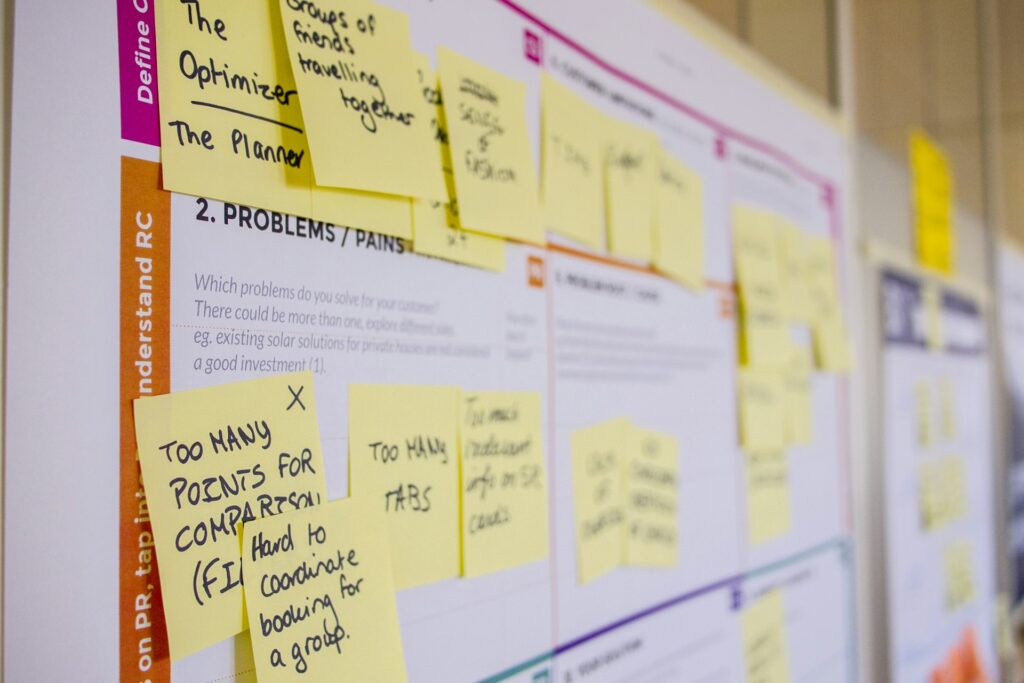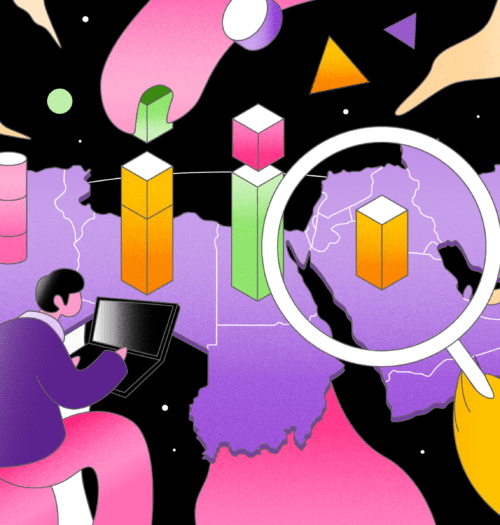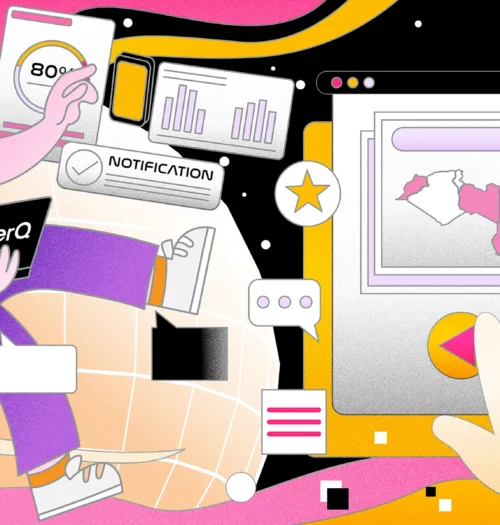🎁 Free 30-day publishing fees on Pay-As-You-GO. Get 15% off when recruiting from the UserQ Panel, with code HELLO15
Maximizing product managers’ ROI with cost-effective remote user testing

The importance of ROI for product managers
Understanding remote user testing
Remote user testing allows you to evaluate your product, prototype or running surveys with real users who are located in different places than the moderators. This setup allows users to interact with your product in their natural environments, such as at home or work, providing more authentic and context-rich feedback.
Remote testing can be conducted in two main ways: moderated and unmoderated.
Ensuring that every product decision contributes to a positive return on investment (ROI) is the ultimate goal of product managers. ROI can help determine whether a new product is likely to be profitable, and thus worth the investment (including the budget dedicated to user research).
ROIs are a reflection of the value and impact business decisions have on the product, the company, and ultimately, the users. As product managers, understanding and maximizing ROI is crucial, especially when it comes to implementing user testing in the product development cycle. Remote user testing, in particular, offers a cost-effective way to gather insights that drive product success while ensuring efficient use of resources.
Moderated remote testing
A facilitator or moderator guides the user through tasks in real-time via video call or screen-sharing software like Zoom. The moderator can ask questions, provide instructions, and probe deeper into the user’s thoughts and actions during the session. For example, if a user is struggling with a particular feature on an app prototype, the moderator can ask follow-up questions to understand the root cause of the issue.
Unmoderated remote testing
Allows users to complete tasks on their own, without a moderator present. Participants are given instructions and tasks to complete in autonomy, and their interactions with the product are recorded for later analysis. This method is often more scalable and cost-effective, as multiple users can participate simultaneously without the need for a moderator. There are various platforms available for conducting unmoderated testing, and UserQ.com is one of them. UserQ.com is specifically designed to run unmoderated testing with users from the MENA region, either in English or Arabic making it an ideal choice for gaining insights from the Middle East.
Both moderated and unmoderated remote testing offer valuable insights, but the choice between them depends on the goals of your research, the budget allocated and the level of detail you need in your findings.
Types of remote user testing methods
Today, you can run remotely pretty much every study that you would typically conduct in a UX lab, with the exception of studies that might require the use of specialized tools for eye tracking or face tracking. This flexibility has made remote user testing an increasingly popular option for running research projects, allowing important saving on logistic expenses.
Here are some common research methodologies, both quantitative and qualitative, that can be effectively conducted remotely, each supported by various digital software and platforms:
1. Remote interviews and focus groups
Interviews and focus groups are powerful methods for gathering qualitative insights from your users. These sessions can be conducted via video conferencing tools like Zoom, Google Meet, or Microsoft Teams, allowing you to explore user experiences, preferences, and challenges in a detailed and interactive way. To enhance the efficiency of these sessions, AI-powered transcription tools such as Otter.ai can be used to automatically transcribe the interviews, making it easier to analyze and document user feedback for UX research.
2. Remote usability testing
Usability testing is essential for evaluating how users interact with your product, whether it’s a website, app, or prototype. This method helps identify usability issues and gather user experience feedback. Platforms like UserQ enable you to run usability tests remotely on both mobile and web prototypes, providing valuable insights into how real users engage with your designs.
3. Remote workshops
Design thinking or stakeholder workshops are collaborative sessions where participants work together in real-time to solve problems, brainstorm ideas, or co-create solutions. These workshops can be conducted remotely supported by digital tools like Miro, MURAL, which facilitate interactive activities such as brainstorming, design sprints, and prioritization exercises. Remote workshops can bring together a large number of users, without the need for physical travel or venue arrangements. This flexibility allows participants from various locations or in different time-zones to collaborate seamlessly and in real-time.
4. Card sorting and tree testing
Card sorting and tree testing are methodologies used to understand how users categorize and organize information, helping to improve the information architecture of your product. Platforms like UserQ offer tools for creating open or closed card sorting exercises and tree tests. By using these tests, you can gain insights into how users expect content to be structured, ensuring that your product’s navigation and content organization align with user expectations.
Running these activities remotely often translates into significant time savings both in conducting the studies and in analyzing the results (no more transcribing sticky notes on your laptop).
5. Surveys, questionnaires, and concept testing
Surveys, questionnaires, and concept testing are essential methods for collecting user feedback on a wide range of topics, from product concepts to user satisfaction. Platforms like UserQ allow you to design surveys using various question types, including free text, single and multiple choice, Likert scale, rating scale, and ranking scale.
Comparing remote vs. in-person user testing

Remote user testing often proves to be more cost-effective, time-efficient, and logistically simpler compared to in-person testing. It allows you to reach a broader audience without the constraints of physical location, ensuring high-quality results while minimizing the resources required for setup and execution.
Here’s some details:
Remote user testing | In-person user testing | |
Costs | – Lower overall costs | – Higher costs due to lab rental and equipment |
– Lower recruitment expenses | – Potentially higher recruitment expenses (compensation needed for travel expenses) | |
Time | – Time-saving in conducting studies remotely | – Time-consuming due to the nature of physical events |
– Automated or partially automated results analysis with built-in features in remote testing | – Time consuming Analysis of the results starting from physical media (sticky notes) | |
– Time framed meetings | – Commuting to the venue adds to time delays | |
Users recruitment | – You can reach a more diverse audience without geographical limits | – Efficiency can be lower if user base is geographically dispersed |
– Same logistic effort for every user involved | – Additional arrangements may be required for distant users | |
Logistics | – Simplified logistics with no need for lab space | – Requires lab space and room bookings |
– No participant limits based on physical space | – Participant numbers may be limited due to space constraints | |
– A remote testing tool is eventually needed to support the activities | – Pens, paper, sticky notes, pre-printed material is often needed to support the activities |
One of the most obvious financial advantages of remote user testing is the reduction in costs associated with travel, renting a UX lab, and purchasing specialized equipment. Participants can take part in testing from anywhere, eliminating the need for expensive travel arrangements and venue rentals. Remote user testing also reduces the overhead associated with coordinating and managing in-person sessions. Without the need to book venues or manage travel logistics, your team can focus more on analyzing results and making data-driven decisions. This efficiency can significantly shorten the product development cycle, leading to faster time-to-market.
By conducting research remotely, you can also reach a larger and more diverse group of participants and ensure that your product meets the needs of different demographics.
Maximizing ROI through effective remote testing strategies
To truly maximize the ROI of remote user testing, it’s essential to implement effective strategies that ensure high-quality results.
Selecting the right tools and platforms
There are numerous platforms available that offer features such as screen recording, real-time observation, and user task tracking to make remote testing valuable. Selecting a tool that aligns with your specific testing needs will ensure you gather the most relevant and actionable data in a time and cost effective way.
Designing effective test plans and scenarios
A well-designed test plan is the foundation of effective remote user testing. Your plan should include clear objectives, defined user tasks, and measurable outcomes. Creating realistic scenarios that mimic real-world use cases will provide you with insights that are directly applicable to your product’s success.
It’s important to remember that during unmoderated studies, users can only rely on the help of your study brief and task descriptions. Any lack of information in these areas can inevitably invalidate the accuracy of your study results.
Recruiting participants: ensuring quality and relevance
The quality and relevance of your participants are critical to the success of your remote user testing. Recruit participants who match your target user demographics to ensure the feedback you receive is representative of your actual user base. This relevance is key to obtaining insights that can drive meaningful improvements to your product.
Especially in remote testing, you want to make sure participants’ identities are verified and their ability to articulate feedback is proven as well.
Analyzing and interpreting data for actionable insights

Collecting data is only the first step; the real value comes from analyzing and interpreting that data to uncover actionable insights. By carefully examining user behaviors, pain points, and feedback, you can identify areas of your product that need improvement and prioritize changes that will have the most significant impact on user satisfaction and ROI. Especially in remote testing, you can benefit from using tools like UserQ, which offer data visualization and organized dashboards for efficient analysis of your study. This is something you might want to consider before subscribing to any testing tools available on the market. Your product’s ROI will be closely related to the amount of time your team spends on analyzing study results. If you plan to introduce user testing in an iterative product development cycle, it’s crucial to ensure that UX data analysis is a streamlined process. The insights from your UX research should also be easily shareable with all stakeholders.
Key metrics to measure ROI in remote user testing
When conducting remote user testing, it’s crucial to measure the return on investment (ROI) to ensure that your efforts are translating into tangible business benefits. Tracking the right metrics not only helps you justify the investment in user testing tools and participant rewards but also provides insights into how effectively the testing is improving your product. The key metrics to consider include:
– the time and cost per response;
– the impact on the product development cycle,
– Increase or decrease in product adoption rates.
Time and cost per insight
One of the most important and easy to measure metrics for remote user testing is the time and cost per insight. This metric evaluates how quickly and cost-effectively your team can derive actionable insights from the user testing process. A lower time and cost per insight indicate that your testing process is efficient and that you’re able to gather valuable feedback without unnecessary expenditure or delay. This efficiency is particularly important in fast-paced development environments where timely insights can make a significant difference in product success.
One factor to consider is that the scale used to measure what’s considered low or high time/cost is relative. The investment is highly dependent on how valuable a specific insight is at a particular time and phase of your product development cycle.
—
To give a practical example:
Suppose I’m running a remote, unmoderated study with 100 participants at a cost of $2 per response. I would be able to collect all responses within 24 hours. Time and cost per response = $2 – 24 hours
Now, let’s use that same estimate to evaluate two different studies:
- A survey to understand my product market fit before allocating a budget and starting the development of the website.
- A preference test to determine which of two UI options users prefer.
Although both studies can be considered fairly important, I would view the investment in the market fit survey as crucial, whereas the preference test for the UI would be more of a “nice-to-have.” Spending $200 and 24 hours of the product team’s time is insignificant compared to what could be wasted if the company decides to launch a product without a validated market fit.
Impact on product development cycle
The impact of remote user testing on the product development cycle is another critical metric to consider. This involves assessing how the insights gathered from user testing influence the speed and direction of product development. Ideally, effective remote testing should lead to faster iteration cycles, reduced time to market, and fewer costly revisions late in the development process. By integrating user feedback early and often, teams can ensure that the product evolves in alignment with user needs, leading to a more streamlined and effective development process.
User satisfaction scores and product adoption rates
User satisfaction scores and product adoption rates are key indicators of how well the insights from remote user testing translate into real-world success. High user satisfaction scores suggest that the product resonates with the target audience and meets their needs, which is a direct reflection of the effectiveness of your user testing process. Similarly, high product adoption rates indicate that the product is gaining traction in the market, further validating the decisions made based on user feedback. These metrics are not only essential for measuring the success of your product but also for demonstrating the value of remote user testing in driving positive outcomes.
Best practices for product managers
For product managers, integrating remote user testing into the product lifecycle is essential for fostering continuous testing, iteration, and maximizing ROI. By embedding user feedback loops into every stage of development, from initial concept through to post-launch, you can ensure that the product evolves in alignment with user needs and expectations. This approach not only helps in identifying and addressing usability issues early but also facilitates rapid iteration, allowing teams to make data-driven decisions that improve product quality, user satisfaction, and ultimately, the return on investment.
In addition to continuous testing, leveraging remote testing data for effective stakeholder communication is a crucial. Clear and concise communication of insights drawn from user testing ensures that all stakeholders, from designers to executives, are aligned on the product’s direction. Using visual aids like dashboards and reports, product managers can translate complex data into actionable insights that are easily understood by non-technical stakeholders. This not only fosters collaboration but also secures the necessary buy-in for implementing changes based on user feedback, further enhancing the product’s ROI.
Related Post

The benefits of user research
User research is typically a key part of product development and business growth all around the world, but here at

Potential of AI in UX
With companies prioritising user-centric design to satisfy customer expectations, the Middle East and North Africa (MENA) area is a fast

Tips to write effective prototype
Success in prototype testing can take many forms. For some, successful testing is when they receive authentic and actionable feedback,
Subscribe to our
product newsletter!
Receive emails about UserQ updates, new features,
offers and latest trends.


